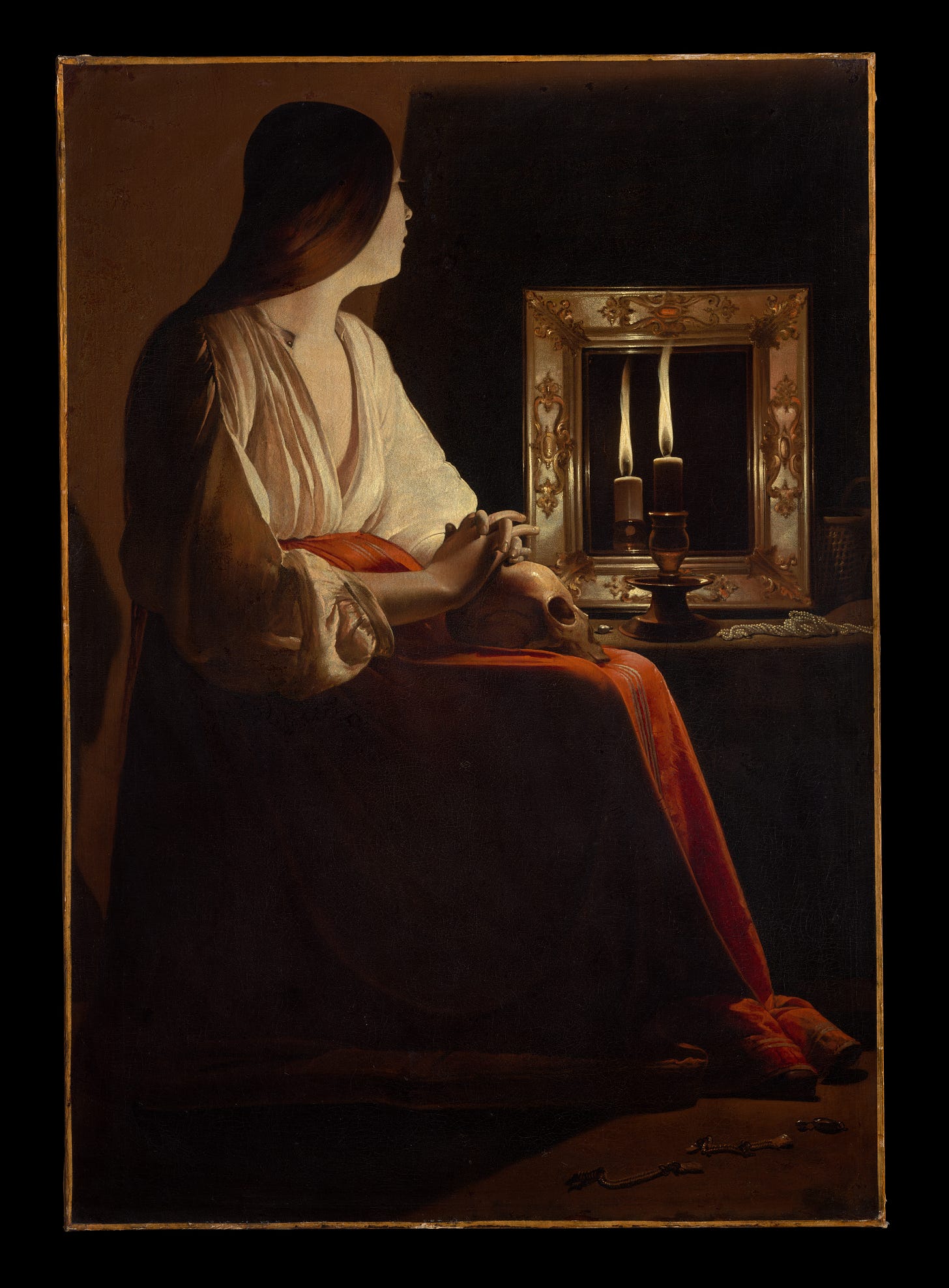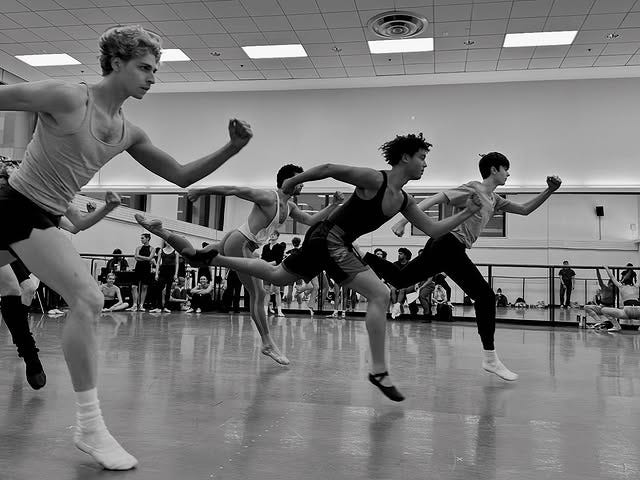Collective bargaining for the ballet
Plus, the unsanctioned exhibit that just opened at the Met.
If you are new to this newsletter—hello and welcome! I am glad to have you. Here’s what I’ve been up to the past week:
On Thursday, I caught Paris Opera Ballet’s performance of Hofesh Shechter’s “Red Carpet” at New York City Center—an entrancing piece which does lose its pacing mid-way, but still delivers a visual treat. I wish it finished as strongly as it started. Shechter’s Batsheva training is very apparent in his movement vocabulary; a lot of the piece reminded me of Sharon Eyal’s “Into the Hairy,” which I saw Nederlands Dans Theater perform in The Hague over the summer (and reviewed here).
After walking through the Met on Saturday, I decided to rush the NY Phil’s Boulez & Bartók performance, conduced by Esa-Pekka Salonen. While I was most excited about Boulez’s “Rituel in memoriam Bruno Maderna,” which was performed along LA Dance Project, I was a touch underwhelmed by Benjamin Millepied’s choreography, which started to feel halting and underdeveloped after a time—a disservice to Boulez’s haunting, dystopian score.
Salonen is a marvel to watch, though. The standout of the evening was Bartók’s “Concerto for Orchestra,” which was so electrifying that, after the first movement, an audience member let out a “woo!” I got my ticket an hour before the show for $22. The box office attendant asked me if I happened to be a student, and I said, “No but thank you for asking me such a question.”
This week, I’ll be seeing Limón Dance Company at the Joyce, ABT’s A Retrospective of Master Choreographers, and Turn It Out with Tiler Peck & Friends at City Center.
I am about halfway through Annie Ernaux’s The Years for my alma mater’s alumnae book club. (Somehow it feels like most of what I have read this year centers on or around WWII). It is not too late for you to read Pamela Hansford Johnson’s The Unspeakable Skipton—I’ll be discussing it at the McNally Editions Book Club next Monday.
You may have seen the news about the dancers of New York City Ballet boycotting last week’s Fall Fashion Gala in protest of NYCB management refusing to come to the bargaining table with a fair deal. Dancers and stage managers, who are represented by the American Guild of Musical Artists, have been working under an expired contract since August 31. The big issue at stake here is pay: inflation, especially the cost of living in New York City, has far outpaced the dancers’ salaries.
Many of the company’s highest profile dancers have spoken out. Principal dancer Jovani Furlan shared a video yesterday pointing out that the dancers took a 4 percent pay cut during the pandemic, and their pay has only gone up 9.7 percent net since (while inflation in NYC is up 22 percent). On average, the dancers spend 48 percent of their earnings on rent. They also work just 37 weeks a year—which means that they are not paid at all for 15 weeks out of the year (which is why it’s not surprising that some dancers, like Furlan and corps member Jenelle Manzi have additional careers as entrepreneurs, why others, like Chun Wai Chan and India Bradley* appear in fashion campaigns, and likely why principal dancer Tiler Peck seems to work 36 hours a day on her many, many side projects).
Since the dancers boycotted the gala, Furlan said, management came back to the table with a proposal of a 0.5 percent salary increase over three years. This proposed wage increase is less than 1 percent of NYCB’s total budget.
Principal dancer Megan Fairchild, who, at 41, will retire after the spring season, expressed her dismay on Instagram: “In the history of NYCB post-Balanchine, the dancers have never had to escalate to this point.”
Fellow principal Mira Nadon spoke to dance critic and journalist
about her involvement in the negotiations. Nadon, 24, is a member of the contract negotiation committee. She said that negotiations have been “slow and arduous” and that as a principal, she feels an obligation to “stand up for the whole shop and address the issues.” A true leader.Ashley Bouder, a former NYCB principal who retired in the winter season, has also been a vocal proponent in favor of the dancers on her Instagram story over the past few days.
It is worth pointing out that New York City Ballet is largest ballet company by expenditure in the United States. Because it is a nonprofit, its finances, including its executive salaries, are also public: executive director Katherine Brown took home nearly $750k in 2024, while artistic director Jonathan Stafford brought in nearly $473k and associate artistic director Wendy Whelan got about $441k.
The artists are now asking that supporters send a letter directly to management via this form.
City Ballet is far from the only dance company to contend with contract negotiations recently. Don’t forget how Dallas Black Dance Theatre fired its entire main company last year after they organized under AGMA. The San Francisco Ballet (the second-largest company in the U.S. by expenditure) reached a two-year agreement last December one day before it was set for its opening performance of The Nutcracker. In June, Texas Ballet Theater became the first North Texas dance company to reach a union contract in more than 40 years. And after American Ballet Theatre dancers voted overwhelmingly to authorize a strike in February 2024, management finally made them an offer they could accept.
Unionization efforts in the ballet world have particularly picked up since the pandemic, The Nation reported last year. “Forming a union is an act of love in a sense,” Griff Braun, AGMA’s national organizing director told the publication. “If you hated the place you worked you would just leave. It’s people who want to stay that want to make it better who form a union. I think that’s an important thing for people to keep in mind and I wish some of our employers would recognize that sooner that these artists are doing this not to hurt the company but to help the company.”
*In more exciting news, India Bradley received a long-overdue promotion! She has become New York City Ballet’s first Black female soloist (which is also wildly overdue). Victor Abreu, Dominika Afanasenkov, Naomi Corti, Mary Thomas MacKinnon, and Andres Zuniga also received promotions to the rank. Congratulations to all!
Last week we talked about all the arts organizations getting in on Saudi Arabia’s cultural funding flush and well would you look at that—Frieze, the London-based art fair, just announced that it will also expand into the Gulf region and launch its Abu Dhabi edition next November, The Art Newspaper reported.
The Charlotte Symphony has taken a cue from Netflix: its rebrand not only has a look, but a sound. The orchestra tapped composer Mason Bates to create a “sonic logo” (like Netflix’s “tadum”) to go along with the redesigned logo it debuted last year. Maestro Kwamé Ryan, who last year became the Symphony’s first Black music director in its 92-year-history, seems to be doing big things. This week, for instance, the Symphony is putting on a multimedia production, “Dolly Parton’s Threads: My Songs in Symphony,” featuring the music of Dolly Parton with her own personally selected guest vocalists.
Another thing I like about the Charlotte Symphony is its various discount offers, including its Music for All program, through which anyone receiving SNAP or WIC benefits can receive $3 tickets to select performances. This is how it’s done!
Here’s a rebrand that hasn’t gone over so well. The Philadelphia Museum of Art is now “Philadelphia Art Museum,” or “PhAM.” Critics called the new logo, by Brooklyn design studio Gretel, “oppressive and bland,” Hyperallergic reported. Others cut to the chase: “We still remember you trying to union bust,” one Instagram user commented, referencing the museum workers’ 2022 strike.
We should also keep an eye on the Cleveland Symphony Orchestra, as music director Cristian Macelaru has officially begun his tenure, the New York Times reported. The orchestra is reportedly in discussions with a number of European festivals about international touring. Macelaru also told the NYT that he wants to bring more living composers into the orchestra’s repertoire.
Here’s a fun tidbit: Marcelaru, now 45, had a bit of a Leonard Bernstein moment in 2012 and again in 2013 that served as the breakthrough for his career. Much like Bernstein famously stepped in for the conductor Bruno Walter to lead the New York Philharmonic at Carnegie Hall in 1943, Marcelaru stepped in twice to cover for the NY Phil’s former music director, Pierre Boulez. In 2013, Chicago Classical Review wrote that he led the Chicago Symphony Orchestra in a “compelling and incisive performance.”
Looks like the new stuff does work. Despite mixed reviews from the pros, people seem really excited about the Metropolitan Opera’s Kavalier & Clay, by the aforementioned Bates and librettist Gene Scheer. The opera will come back for four more performances in February and will show a pre-recorded screening of the opera in movie theaters across North America. These encore performances are highly unusual, the New York Times, noted; only once before did the Met do a same-season revival, with its 2019 production of Porgy and Bess.
The stats for its attendance are startlingly good: 87 percent of paid seats were sold for all seven shows, 35 percent of attendees were seeing their first Met performances, and 30 percent were 40 or younger.
As we previously discussed, the staff of Venice’s La Fenice opera house are very displeased over the appointment of hard-right conductor Beatrice Venezi as music director. Now, they will officially strike this Friday, when the first performance of Alban Berg’s Wozzeck is scheduled, The Guardian reported.
Below the paywall: An unexpected MoMA collab, a new routine for the National Symphony Orchestra, a big acquisition at LACMA, an unauthorized exhibit at the Met, and more.
Keep reading with a 7-day free trial
Subscribe to Mezzanine Society to keep reading this post and get 7 days of free access to the full post archives.





